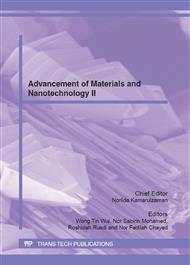p.124
p.129
p.137
p.143
p.148
p.153
p.157
p.161
p.165
Characterization of LiMn0.3Co0.3Ni0.3Cr0.1O2 and LiMn0.333Co0.333Ni0.333O2 Synthesized via Sol-Gel Method: XRD, SEM and XPS Studies
Abstract:
One of the aspects most intensively researched in the continuing improvisation of lithium battery is the search for high capacity, high energy density and high performance cathode materials. Substitution of the electroactive elements with heteroatoms is one of the promising methods. In this study, a potential cathode material with a layered structure was successfully synthesized via a sol-gel method. As a comparison, the well-known LiMn1/3Co1/3Ni1/3O2 (LiMn0.333Co0.333Ni0.333O2) was also synthesized using exactly the same method and conditions. Both materials were characterized using simultaneous thermogravimetric analysis (STA), X-ray powder diffraction (XRD), field-emission scanning electron microscopy (FESEM) and X-ray photoelectron spectroscopy (XPS). The stoichiometries of the compounds were also confirmed through energy-dispersive X-ray spectroscopy (EDX) measurement. XRD results show that both compounds are single phase and impurity-free with well-ordered hexagonal layered structure characteristics of R-3m space group. Both compounds also show similar morphologies with well-formed crystals and clean surfaces as depicted by the SEM images. XPS measurement reveals that the introduction of chromium into LiMn1/3Co1/3Ni1/3O2 results in a considerable change in the chemical environment as observed by significant changes in the binding energies (BE) of manganese, cobalt and nickel respectively.
Info:
Periodical:
Pages:
148-152
Citation:
Online since:
July 2012
Keywords:
Price:
Сopyright:
© 2012 Trans Tech Publications Ltd. All Rights Reserved
Share:
Citation:


